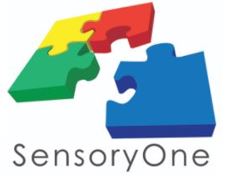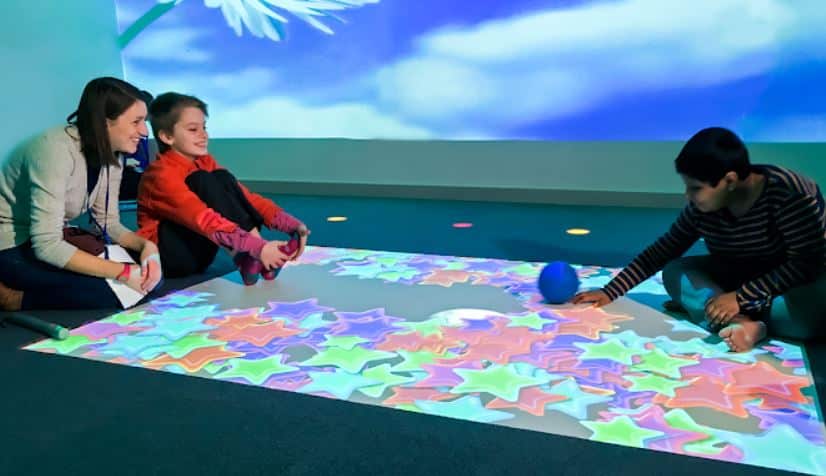
Sensory rooms are specially designed spaces that aim to provide individuals with sensory experiences to promote relaxation, stimulation, and therapeutic benefits. These rooms are particularly beneficial for individuals with sensory processing difficulties, developmental disabilities, or those seeking a calm and engaging environment. These benefits extend to both children and adults alike. Among the various elements that contribute to the effectiveness of a sensory room, interactive projectors stand out as a powerful tool for creating immersive and interactive experiences.
At SensoryOne, we offer the highest quality, award winning interactive projector systems by OM Interactive across the USA and Canada.
Reasons why interactive projectors are a great addition to sensory room design:
- Engagement and Interaction: Interactive projectors offer individuals the opportunity to actively engage and interact with projected images or content. Through touch, gestures, or other input methods, users can directly manipulate the projected visuals, creating a dynamic and participatory experience. This active engagement stimulates their senses and encourages their involvement, making the sensory room more captivating and enjoyable.
- Multi-Sensory Stimulation: Sensory rooms aim to provide multi-sensory stimulation to engage various senses such as sight, sound, touch, and sometimes even smell. Interactive projectors contribute to this stimulation by projecting vibrant visuals, colorful patterns, and moving images, appealing to the visual senses. By combining these visuals with accompanying sounds and tactile elements, such as projected textures or vibrations, interactive projectors enhance the overall sensory experience within the room.
- Customization and Flexibility: Interactive projectors offer a high degree of customization and flexibility. They can be programmed to display different types of content, including games, educational materials, relaxation scenes, or therapeutic visuals. This versatility allows the sensory room to adapt to the specific needs and preferences of individuals using it. Caregivers or therapists can customize the projected content based on the user’s developmental stage, therapeutic goals, or sensory sensitivities, ensuring a tailored and effective experience.
- Therapeutic and Educational Benefits: Interactive projectors can be utilized to deliver therapeutic and educational interventions within a sensory room setting. They facilitate learning experiences, promote cause-and-effect understanding, improve hand-eye coordination, encourage social interaction, and enhance cognitive development. The interactive nature of these projectors enables therapists to create personalized activities that target specific skills or address sensory integration challenges, making the sensory room a valuable therapeutic environment.
- Safe and Non-Intrusive: Unlike some traditional sensory room equipment, such as swinging platforms or balance boards, interactive projectors pose minimal physical risk. They eliminate the need for individuals to engage in potentially challenging or strenuous physical activities. This feature makes interactive projectors suitable for people with diverse physical abilities and sensory sensitivities, ensuring a safe and inclusive environment where individuals can comfortably explore and engage with the projected content.
With the ability safely and efficiently create amazing user experiences, education, therapy and multi-sensory stimulation, interactive projector systems are integral to sensory room environments. Individuals can benefit from immersive and personalized sensory experiences that promote relaxation, engagement, and development.
Multiple Settings in Which Interactive Projectors are Utilized
Interactive projectors are versatile and can be beneficial in various settings where sensory experiences, engagement, and interaction are desired. Here are some settings where interactive projectors are particularly well-suited:
- Sensory Rooms: Interactive projectors are an ideal addition to sensory rooms designed for individuals with sensory processing difficulties, developmental disabilities, or therapeutic needs. They enhance the sensory environment by providing engaging and interactive visuals, promoting stimulation, relaxation, and therapeutic benefits.
- Education and Learning Environments: Interactive projectors are valuable in educational settings, such as classrooms or specialized learning environments. They offer opportunities for interactive lessons, visual demonstrations, and immersive educational experiences. Students can actively participate, manipulate content, and explore subjects in a more engaging and interactive manner.
- Rehabilitation Centers: Rehabilitation centers, including physical therapy or occupational therapy facilities, can utilize interactive projectors to enhance therapy sessions. The interactive nature of these projectors can be used to encourage movement, coordination exercises, cognitive stimulation, and other therapeutic interventions, making rehabilitation sessions more enjoyable and effective.
- Entertainment Venues: Interactive projectors can be incorporated into entertainment venues such as museums, theme parks, interactive exhibits, or interactive art installations. They provide an interactive and immersive experience for visitors, allowing them to engage with the content, play games, and explore interactive narratives, enhancing the overall entertainment value.
- Special Needs Schools and Centers: Schools and centers catering to individuals with special needs can greatly benefit from interactive projectors. They can be used to create inclusive and interactive learning environments, promote social interaction, facilitate sensory integration activities, and support the specific educational and therapeutic needs of students.
- Elder Care Centers and Seniors Living: Highly sought after for a reason, interactive projectors are commonly a favourite of senior home programming directors. The benefits for seniors range from therapeutic to entertainment.
- Hospitals and Healthcare Facilities: Interactive projectors can be utilized in hospitals, pediatric wards, or healthcare facilities to create a more comforting and engaging environment for patients, particularly children. They can display calming scenes, interactive games, or educational content to alleviate anxiety, distract from medical procedures, and enhance the overall patient experience.
- Community Centers and Libraries: Interactive projectors can be installed in community centers or libraries to offer engaging and interactive activities for individuals of all ages. They can be used for educational workshops, interactive storytelling, group activities, or creative projects, fostering community engagement and promoting learning in a fun and interactive way.
Clearly, interactive projectors are well-suited in a range of public and institutional settings from educational to care and rehab centres. Their versatility and ability to create immersive and interactive experiences make them valuable tools in enhancing engagement, learning, therapy, and entertainment in a wide range of settings.




